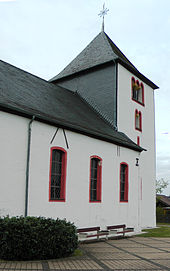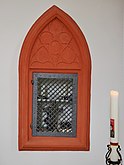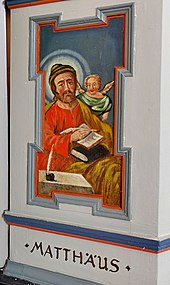Evangelical Church (Hirschfeld Hunsrück)
The Evangelical Church Hirschfeld is the Evangelical village church in Hirschfeld , a municipality in the Rhein-Hunsrück district in Rhineland-Palatinate .
history
Parish
A chapel in Hirschfeld consecrated to St. Wendelin is first mentioned in 1353. The Reformation was introduced in 1557 in the village that was then part of the parish of Kleinich. Hirschfeld had an independent parish to which the neighboring village of Horbruch also belonged. Until 1884, however, the community had no pastor of its own and was also looked after by the pastor of the Kleinich parish 6 km away . In 1884, Hirschfeld-Horbruch and Krummenau broke away from the parish and formed a separate pastor's office based in Horbruch and had their own pastor until 1969. In 1973 the pastorate was abolished and the three parishes were merged to form the Christ parish Kleinich .
Simultaneum
The Catholic sovereign Hugo Ernst Cratz von Scharfenstein enforced in 1704 due to the religious freedom declared during the attempts at recatholization during the French occupation in 1868 that the church, which had previously also been used for Catholic services, became a simultaneous church . At his expense, church equipment was purchased for the Catholic services and a separate altar was erected.
The construction of the new nave
On November 21, 1747 Pastor Georg Wilhelm Streccius asked the consistory in Trarbach and the sovereigns, the Count Solms von Rödelheim, on behalf of the heads and members of the parish, for permission to demolish the old church, with the exception of the tower, and to rebuild it larger and better it had become not only too small, but also dilapidated and uncomfortable due to the growing number of parishioners. The building permits were quickly obtained and on April 13, 1748 construction began with the ironing of the old nave. Building materials and craftsmen were paid from the church gradient. The parishioners had to do the auxiliary work and haulage themselves and free of charge. Although the church was already a simultaneous church at that time, the construction was organized and financed by the Protestant parish alone. Even before construction began and during the entire construction period, there was a dispute with the Catholic pastor Philipp Christian De Magritta. The main points of contention were the stone (Protestant) altar, the location of the baptismal font , stalls and pulpit . Another point of contention was whether the Catholic Electorate had a ius episcopale with regard to Hirschfeld . and thus has a say in church building.
The new church interior was inaugurated on December 17, 1749. 20 students from the Trarbach Latin School, together with their vice-principal Storck and their cantor Glaser, provided the musical accompaniment. Pastor Streccius gave the sermon on the feast of the consecration of the church on Joh. 20:22. In addition to his official brother Lauer from Irmenach, many residents and people from the neighborhood were present. After the festive service there was a celebration in Horbruch and the guests were treated in the most wonderful way .
Disputes between denominations
The disputes between the denominations lasted until the dissolution of the Simultaneum on October 1, 1929. There were disputes about the times of service, especially when the Protestant service was delayed and the Catholics had to wait. In 1752 a fight between Protestants and Catholics that arose on this occasion has been handed down. Another point of conflict was whether Catholics are allowed to hold early mass. In 1844 the Protestants provided the church door with an additional lock, which the Catholics tried to force open. Other points of contention were the beginning of the church services and the Catholic school as well as the installation of the altars and the confessional. Several of these disputes ended in court. The basic problem behind all of this was that the Protestant parish saw itself as the owner of the church in which it had to allow the Catholic parish a limited number of services, but the Catholic side saw itself as co-owner of the church, but did not participate in the renovation costs . Conversely, the Catholics wanted to take part in the renovation in 1840, but were rejected by the Protestants for fear of expanding their rights. When the first land register was created in 1892, the Protestant parish was initially registered as the sole owner of the church. After a legal dispute through several instances, the Koblenz Regional Court ruled that the church was jointly owned by both denominations, the sacristy was the sole property of the Catholics and the space above the sacristy was the sole property of the Evangelicals.
At that time the church was structurally in poor condition. During the renovation in 1900, when the roof and windows were repaired, a steel tie rod was also drawn in to prevent the two longitudinal walls from drifting apart. The Catholics participated for the first time with half the cost.
Dissolution of the Simultaneum
Beginning in 1894, efforts were first made by the Catholic side to dissolve the Simultaneum, to build their own church and to leave the old church to the Protestants in return for a compensation payment. The Protestants could not agree whether they should buy the old church if the Simultaneum was dissolved or build a new church in Horbruch , which belonged to the parish and in which more parishioners lived than in Hirschfeld. After the Catholics built their own church in 1923 and were no longer willing to take part in the urgently needed repairs to the simultaneous church, negotiations, in particular about the amount of the fee, were resumed. Finally, the Simultaneum was dissolved on October 1, 1929. Although the Catholics originally called for at least one bell to be moved to their new church, they stayed where they were. With the support of the Provincial Synod, the Evangelicals were also able to pay the last installment of the redemption in September 1930, which meant that the simultaneous relationship was legally completely dissolved.
From the First World War to the present
After part of the church ceiling fell in 1930, the urgently needed renovation work could be carried out in 1932. On December 11, 1932, a large parish festival took place in the newly built, now purely Protestant church.
With the exception of the oldest bell, the bells had to be delivered during World War II . They came back almost intact in 1948. More extensive restoration work took place in 1966, from 1986 to 1991 and 2017.
use
As a result of the merger of the parishes of Kleinich , Hirschfeld-Horbruch and Krummenau in 2008 , the pastor responsible has to look after four churches. Since then, services have been held every two weeks in Hirschfeld, as in the other churches. It is also used from time to time for concerts and events.
architecture
Today's church consists of a Romanesque choir tower and a nave in the form of a baroque hall building attached to the tower in the west. The mighty Romanesque tower was changed in the 14th century. On the tower there is a square pyramid roof from 1840, which is surmounted by a metal cross. On the ground floor of the tower is the 4.50 m wide choir of the church with a 14th century sacrament niche and an ogival tracery window. Three historical bells hang in the belfry.
The nave, built in 1749, is 9.42 m wide and about 20 m long. It has three windows on the long sides and two small windows at the level of the organ gallery on the west side. The entrance to is on the west wall. It is protected by a wooden porch with four pillars and a hipped roof. A fresco above the choir arch that was uncovered in 1989/90 has Isaac's sacrifice as its motif. There is a dedicatory inscription uncovered in the same year.
- Interior
The church has a wooden pulpit with oil paintings of the four evangelists.
- Evangelist pictures on the pulpit
The pictures of the Twelve Apostles are in the organ gallery. It was James the Less by Paul replaced.
- Images of the apostles on the west gallery
Since 1970/71 the church has owned a small organ from the Oberlinger organ building company .
organ
For the first time in 1967 the purchase of an organ could be considered. In 1969 three offers for small organs could be presented to the regional church office. On June 12th the church was opened by the regional church organ expert Dr. Hornemeyer visited. He recommended a simple instrument due to the exceptionally good room acoustics. With regard to organ maintenance, he recommended to hire a company nearby. Against this background, the Oberlinger company was commissioned to build the organ. The instrument was put into use on January 24, 1971.
The organ has 5 registers in the manual and an attached pedal without its own register and a total of 344 pipes . It has a mechanical action made of light metal, registration loops made of phenolic plastic and an electric blower system.
The organ's disposition is:
|
|
|||||||||||||||
- Pairing : I / P
Bells
| No. | image | Casting year | Foundry, casting location | Mass (kg) | Chime | inscription | Others |
|---|---|---|---|---|---|---|---|
| 1 |

|
1481 | Clais from Echternach | 450 kg | g sharp 1 | (in minuscules) clais von echternach gois mich o Agia o Adorate o Alpha er - o salua nos Anno dni mcccclxxxi | Was evacuated on August 12, 1942 during the Second World War and returned from Hamburg almost intact in 1948. |
| 2 |

|
1545 | Diderich Wolf from Trier | 235 kg | c sharp 2 | (in minuscules) in godes eren lude ich bos wedder verdriven ich diderich wolf van trier gos me 1545 | Was evacuated on August 12, 1942 during the Second World War and returned from Hamburg almost intact in 1948. |
| 3 |

|
1762 | Wilhelmus Stokke | 142 kg | dis 2 | COMET LET'S ADOR TO YOU ECTI MR.PARHER GWSTH SCHULTEIS IN EMERICH WILHELMUS STOKKE GOS ME ANNO 1762 |
literature
- Peter Schößler, Evangelical Church Hirschfeld 1748 - 1998 , commemorative publication for the 250th anniversary on August 22nd and 23rd, 1998; 1998
- Evangelical Christ Church Community of Kleinich; Evangelical Church in Hirschfeld in the Hunsrück , edited by Peter Schößler, Ravengiersberg; published for the 500th anniversary of the Reformation on October 31, 2017 and to mark the end of the renovation work
Web links
- The Protestant Church on http://www.hirschfeld-hunsrueck.de
- Hirschfeld-Horbruch on the pages of the church district Trier
Individual evidence
- ^ Erik Zimmermann: The parish of Kleinich: nine villages in the Hunsrück .; Pp. 243-249
- ↑ http://www1.ekir.de/trier/58.0.html Krummenau on the pages of the Evangelical Church District Trier
- ↑ Archive link ( Memento of the original from May 18, 2015 in the Internet Archive ) Info: The archive link was inserted automatically and has not yet been checked. Please check the original and archive link according to the instructions and then remove this notice. Choir concert in the church. Retrieved May 10, 2015
Coordinates: 49 ° 53 ′ 45.8 " N , 7 ° 14 ′ 36" E























